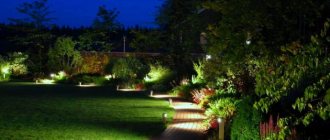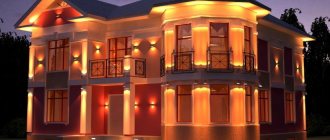How does LED lighting work and why is it so popular?
In LED lighting, the light source is an LED, a semiconductor device with an electron-hole junction that produces optical radiation when electric current passes through it in the forward direction. Different types of LEDs differ in brightness, power and other characteristics, but it is believed that using all of them is more profitable than classic Ilyich lamps. Let's compare:
- an incandescent lamp in total can burn no more than 1000 hours;
- LED up to 100,000 hours (11 years).
LED lamps are also valued for their high light output.
- The luminous efficiency of an incandescent lamp is 7-17 lumens per watt;
- LED lamp - 50-100 lumens per watt.
Planning a lighting system
The first thing, as you already understood, is that you need to decide how much and what kind of light there will be. Next, you need to do a schematic drawing, which indicates important areas, as well as the connection to the power supply. Consider a separate automatic switch for street lighting - it’s convenient and reliable at the same time.
If you need clear instructions on how to make street lighting, we present you with a guide that will definitely help with solving this problem.
You just need to take into account some of the nuances of your summer cottage, as well as the power supply network. Copy the plan of your entire estate from the technical passport. A scale of 1 to 100 will be enough. Place several lighting points in the places where the devices will be.
Using the resulting situational diagram, create an electrical diagram. Here you will have to take into account all the switches. In addition, try turning on other electrical devices in your area - it could be a bell or others.
It is enough to have basic skills in handling electricity, and this task is half solved. After all this, you can begin installing landscape lighting and connecting to the network.
What technical characteristics of LEDs should you pay special attention to when purchasing?
When it comes to diodes, slightly different parameters are important than in traditional types of electric lighting. The most important parameter is luminous flux (lm or lm). It shows how much light energy the lamp gives off. They also use the “luminous efficiency” (lm/W), which indicates how effective the light device is.
Luminous flux is inextricably linked to color temperature , which shows in what shade the lamp glows. Color temperature is measured in Kelvin. Experts recommend warm colors for residential premises, and neutral colors for the office, kitchen and bathrooms. If the lamp uses LEDs with TC≥5300°K, it is not suitable for home lighting.
Another important indicator is power . The power of a LED lamp is calculated using the formula:
Divide the desired wattage of a traditional incandescent lamp by eight.
But manufacturers usually mark the LED lamp with the power values of an incandescent lamp that correspond to it.
When choosing an LED lamp, the dispersion angle - this parameter shows how widely the light flux spreads in space. A lamp for general use must have an angle of at least ≥210°.
Dale85FORUMHOUSE user
And where directional light is needed, a lamp with a dispersion angle of 120 degrees is suitable.
How to ensure the safety of electrical wiring on the site?
Firstly, if you are not an electrician or a builder, entrust this task to professionals. Incorrectly done electrical wiring can lead to serious problems: from a short circuit to a fire. It's not worth taking risks with this.
Secondly, it is recommended to consider the placement of wires and sockets in such a way that there is minimal risk of damage to them by people and animals. Therefore, they should either be buried in the ground or parallel to blind areas, walls, paths, in general, any other protrusions behind which they can be hidden and hidden from accidental damage.
Thirdly, you need to choose the right cables and sockets - for outdoor use. This means that they must be reliably protected from the sun's UV rays, temperature changes, water, snow, ice and dust. It is best to choose devices with the maximum protection and tightness classes: IP 65 and IP 67. Otherwise, after the first winter, you may encounter the fact that your sockets or lamps will refuse to work.
And, of course, it is better to plan the installation of sockets and lamps in the garden in advance - even before laying the paths with tiles, laying the lawn or planting flowers in the beds. Otherwise, you will have to dig through them to get the wires into the ground. This is not difficult, but it is more expensive and, of course, will spoil the aesthetics of your garden for some time.
Did you find this article helpful? Please share it on social networks: Don't forget to bookmark the Nedvio website. We talk about construction, renovation, and country real estate in an interesting, useful and understandable way.
What types of LED lighting can be used in the home?
Three types of lighting fixtures are usually considered
- LED Strip Light
- LED ceiling light (chandelier)
- led panels
Each device solves specific problems.
An LED strip (a flexible board with diodes, each of which is enclosed in a housing and conductive copper tracks) located behind the cornice and directed at the white ceiling turns it into a lighting fixture that floods the room with white light, necessary for work, cleaning, etc. Most often used to illuminate interior items. If you mount the tape around the perimeter of the room, you can visually expand the room.
An LED chandelier gives an even, pleasant light without flickering and always decorates the interior.
Ice panels are installed in large rooms; they are thin, so they are great for low ceilings. They are divided into built-in and suspended.
Automation of turning on and off country lighting
The idea of creating a system that could control lighting in a country house with a given logic has been implemented for quite a long time. Therefore, today you can choose the most suitable option for you and purchase a special device.
The most common devices for automatic lighting are:
- photo relay - the system turns on the light in the dacha when the light level decreases and turns it off after sunrise, when the brightness of the sun's rays affects the photocell;
- motion sensor – allows you to turn on the lights in the dacha if movement is detected in any area;
- time relay - allows you to set the time for turning on and off the dacha lighting at a certain frequency;
- microcontroller (for example, based on Arduino) - a more modern solution for operating light in the countryside, allows you not only to set the frequency, but also to change the brightness, sequence, etc.
Which form of LED lamps is better?
It depends on the purpose of the lighting device. Among the variety of LED models, three are the most popular: Pear. This is the most common type of LED light bulbs; it looks similar to a traditional incandescent lamp with a luminous flux distribution angle of 180 to 360 degrees. Suitable for almost any chandeliers, lamps and other devices. Corn . Reminiscent of a corn cob, with “grains” in the form of ice crystals. It glows brightly, but there is little illumination. Such models are used in spotlights.
Candle . Very compact, with low luminosity (500-600 lm), suitable for night lights, table lamps and other local lighting devices.
Light tasks
Outdoor lighting serves not only as a decorative element (for illuminating parties), but also performs an aesthetic function.
In addition, the area filled with light repels all kinds of intruders. There are so many lighting options on the site that every homeowner can choose his own.
Is it possible to use LED lighting in a cottage as the main one?
Truly high-quality LED lighting is still very expensive, and if the goal is only savings, then there most likely won’t be much point in it.
Vop495
I have not yet seen lamps with normal color rendition that would pay for themselves in at least two years and cost reasonable money.
But from a design point of view, LEDs can be indispensable for a number of solutions (in profile structures, in eaves lighting). FORUMHOUSE users readily use LEDs in shower cabins, kitchen hoods, and bathrooms.
Tulipa1 Member FORUMHOUSE
I have two 12 W lamps (so-called corn) in the bathroom, a 12 W lamp (warm white) in the toilet, and three 16 W lamps (cool white) in the kitchen - my wife is very happy, there’s just a lot of light.
Designing connections for other electrical devices
Electrical wiring throughout the site will also be necessary if you plan to install various devices from the “smart home” series on the site:
- Automatically opening gates;
- Soil moisture sensors;
- Remote start of the plant watering system;
- Motion sensors;
- Video cameras;
- Monitoring pond water quality;
- Heating of sidewalks, paths and stairs;
- Automatic control of a garden fountain.
All these mechanisms require a constant connection to the electrical network.
Therefore, if you are concerned about making your home smart, you should design the electrical wiring on the site in such a way that it is convenient to connect various devices. This is the only way you can take full advantage of various technological innovations.
So, for example, a bell installed at a gate or entrance gate will not work without electricity. In addition to planning the electrical point for this location, it is important to properly protect it from the harmful effects of weather conditions, particularly rain and snow. One solution is to purchase a model with a sealed case to prevent moisture or water from getting inside the device. However, there is a simpler solution - just put a tin or plastic lid on it.
The intercom is usually installed at the gate or at the entrance gate, which also needs to be taken into account when distributing electrics around the site. Although the wiring to the intercom can be parallel to the lighting wires for the gate and garage.
But I still want LED lighting, what are the rules for different rooms?
According to a user of our portal with the nickname Dale85, who is a professional in lighting, the basic rules for LEDs are the same as for other light sources:
- Avoid directional light in the house, which creates unnecessary shadows;
- In the living room, place the chandelier closer to the seating area and away from the passage;
- The kitchen must have a lamp above the table;
- A common mistake is sconces in the bathroom. There you need a full-fledged light source from the ceiling;
- The hallway and boiler room need a lot of light.
Varieties
Landscape lighting is an important aspect that can make a yard or garden visible and even mysterious after sunset. This is necessary so as not to accidentally spoil the flower garden or beds in the dark.
It is only necessary to approach the organization of light distribution scrupulously.
Requirements
When lighting a summer cottage, you need to take into account a lot of nuances. Basic requirements:
- the presence of safe electrical wiring, inclusion of an RCD and a circuit breaker in the circuit;
- convenient lighting control;
- all elements must be “outdoor” use, protected from moisture and dust;
- the cable to be laid must be in a tube or foil;
- lighting should run along the entire perimeter so that all corners of the territory are visible;
- it is more practical to use energy-saving lamps;
- availability of a lighting scheme for the area.
DIY cable installation - instructions
The technology for installing wiring cables includes several stages. For work you will need screwdrivers (simple, Phillips), drill or screwdriver, indicator screwdriver, rubberized gloves.
Installation of distribution panel
A distribution board is needed for installing the power cable and further distributing energy through the wiring. The panel is responsible for accounting, normal operation and safety of the entire electrical system. The device is sold ready-made; externally it is a box with a door, inside it has a DIN rail and a grounding bus.
The shield is mounted vertically 1.2-1.5 m from the floor, preferably on a very strong wall. Markings are applied to the base, holes are drilled along it, and the shield is attached to the screws. Then a residual current device, a counter, and machines connected to each other by jumpers are placed on the DIN rail. The necessary cables are supplied along each line.
Cable entry into the room
The cable is brought into the house underground or by air. It is better to use the first method, placing the wire 40 cm underground. 20 cm of sand is placed in a trench 80 cm deep, then a protective corrugation is installed through which a special cable is laid. Afterwards, another 20 cm layer of sand is made and the trench is covered with earth. If you decide to run the power cable over the air, you need to install supports at every 20 m distance. A non-flammable sleeve is placed in the wall at the cable entry point.
Installation of overhead switches and sockets
Before installation, you need to remove the switch key and the front panel and remove the mechanism. Place the back of the device against the wall and make a level mark. Drill holes with a drill and secure the body with dowels. Strip and connect the cables - phase to phase, zero to zero, ground to ground. After fixing the terminals, you can return the front panel to its place, completing the assembly of the device. Sockets are attached in the same way.
Connecting cables and contacts
The use of twists when installing wiring is not allowed - in wooden walls this can cause a fire. It is best to use whole pieces of cables. If this is not possible, cut off the cables with a margin of 20 cm, and use high-quality terminal blocks (terminal blocks) for connection. They have pressure plates or screws, the former being considered more suitable. The cables are inserted into the terminals, pre-stripped, after which they can be laid in the wall.
Where is light needed?
Professionals believe that it is imperative to conduct electricity near the main building, in the local area, in garden alleys, on verandas, near ponds and plants.
Properly executed street lighting in a suburban area will fill the atmosphere in the evening with magic.
Preparation of a power supply project
At the stage of repairing or even building a house, you should prepare a project for its electrification. For this purpose, the owner is obliged to write an application to the regional office of Gorset, which will be reviewed by specialists. Then they will draw up a contract and technical conditions. Next, you can prepare a project that takes into account a number of standards. Main parameters reflected in the project:
- power of network cables - calculated taking into account the availability of electrical appliances, 30% is added to the figure for reserve;
- wiring cross-section – for all groups the type and cross-section of conductors is indicated;
- a specific layout of electrical points - it reflects sockets, panels, distribution box, entry point of the main cable and other data;
- distance of electrical points from the floor, ceiling, doors and windows.
It should be remembered that wiring can only be laid vertically or horizontally, and the angle of rotation of the cables must be 90 degrees. Access to sockets and other points must be free. Recommendations for calculating the number and installation of electrical points are as follows:
- switch height – 80-150 cm from the floor;
- height of sockets – 50-80 cm from the floor;
- number of ceiling lamps – one per 10-15 sq. m;
- number of sockets – one per 4-6 sq. m;
- power of the main distribution board - from 15 kW, presence of an RCD;
- the minimum distance of the cable from the openings is 10 cm;
- cable distance from metal elements – 15-30 cm.











